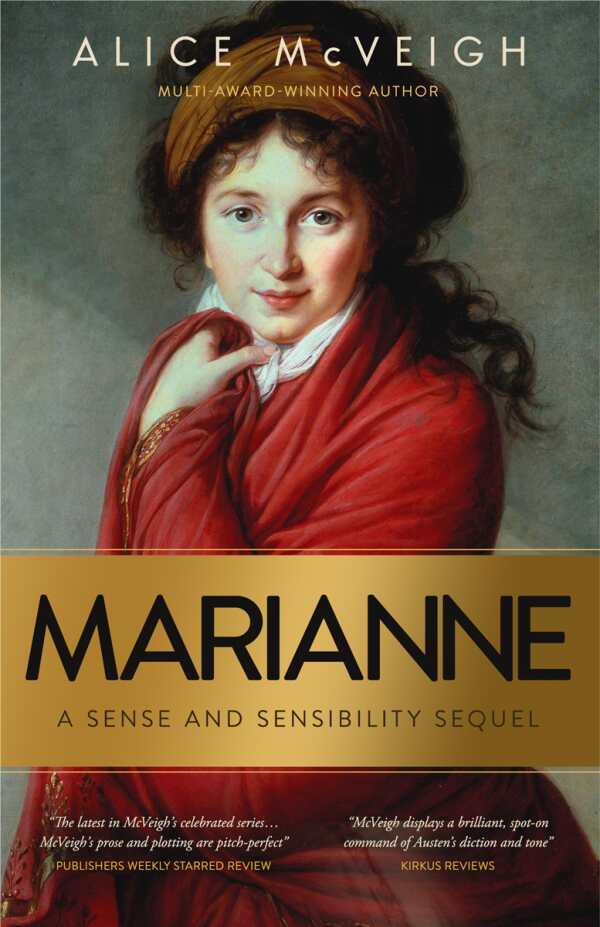
Marianne
A Sense and Sensibility Sequel
A heart is healed, and a future forged, amid the bustling gossip and drama of English society in the charming Jane Austen–inspired novel Marianne.
Set in Regency-era England, Alice McVeigh’s delectable romance novel Marianne is about unexpected love and redemption.
After just a year of marriage to Colonel Brandon, young Marianne is widowed. After she returns to town, her life is upended once more by an unexpected love triangle. Now, with the reappearance of Mr. Willoughby—the lover who broke her heart three years earlier—and the attention of scandal-embroiled Mr. Crawford, Marianne must determine whether she can learn to love and trust again.
The story begins two years after Brandon’s death. Its intricate storyline unfolds in large part through excerpts from Marianne’s and her younger sister Margaret’s journals, which provide a window into the young women’s fears and longings. Few details are given about Marianne’s life with Brandon, however, despite the air of grief that permeates her writings.
Other plotlines, like Willoughby’s marriage and Crawford’s escapades, are narrated beyond the diaries. Much of the expansive cast is drawn from myriad Jane Austen novels, and prior familiarity with the respective works is a boon when it comes to following the complex plot, particularly Marianne’s and Willoughby’s recollections of their past. The list of characters and novels at the beginning of the book helps with the task, though.
The lively cast contributes alternating moments of humor and heartache. Bumbling Rushworth pursues uninterested Marianne with admirable gusto, while the Churchills prove to be steady friends. Young Margaret is a particular delight. She skips through life with winsome cheer and the unwavering belief that thrilling romance awaits. Margaret dreams of becoming a celebrated writer, and amusing snippets of her wild stories are scattered throughout her diary. “Is not ‘perspicacious’ a divinely long word?” she reflects in one lighthearted entry. But Margaret finds more fame than she bargained for when her near brush with scandal propels the plot toward its merry conclusion.
The book’s attention to historical detail and customs is impeccable, as when it describes Marianne’s partial mourning attire. And the book adds an intriguing layer of social commentary as characters discuss the effects of social rules, like the disproportionate consequences of infidelity for women versus men. Poetic prose lends the story further depth, though its overreliance on dashes and ellipses results in some choppiness that detracts from moments of true turmoil.
Characters often hint at their feelings through bits of poetry and playacting, and their borrowed verses pair with stolen kisses to create a thrilling, almost breathless undertone of longing. Indeed, theater propels much of the characters’ conflict and past heartache. The motif of acting and poetry throughout is a fitting parallel to Marianne’s struggle to discern her own heart and then voice her desires. In the story’s climactic scene, a suitor declares to Marianne that her “pilgrim soul can never age” and entreats her to grow old with him. Such poetic declarations elevate the writing without taking away from the raw humanity of the characters. Crawford must still face the people wounded by his carelessness, while Marianne must coax open her grieving heart. Their growth grounds the narrative amid the bustling gossip and drama of English society.
Marianne is a Regency-era romance novel that sparkles with heart and wit.
Reviewed by
Vivian Turnbull
Disclosure: This article is not an endorsement, but a review. The publisher of this book provided free copies of the book and paid a small fee to have their book reviewed by a professional reviewer. Foreword Reviews and Clarion Reviews make no guarantee that the publisher will receive a positive review. Foreword Magazine, Inc. is disclosing this in accordance with the Federal Trade Commission’s 16 CFR, Part 255.
